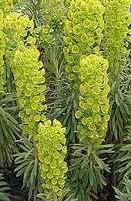 If you know this shrubby perennial by its common name, Mediterranean spurge, you probably know that it thrives in dry hot climates. And you can probability guess that it languishes in hot humid areas. Well-drained soil and full sun produce the best looking plants with rounded form, multiple woody stems, and linear evergreen leaves that are spirally arranged along the stems. Large flower heads are borne at the top of the stems and are made up of dense clusters of showy chartreuse bracts around insignificant flowers. Flower heads last for many weeks from spring to summer. They are lovely in bouquets but care must be taken when cutting the stems because the stems exude a white latex sap that may irritate the skin. Burning the cut end when using in arrangements seals in the sap.
If you know this shrubby perennial by its common name, Mediterranean spurge, you probably know that it thrives in dry hot climates. And you can probability guess that it languishes in hot humid areas. Well-drained soil and full sun produce the best looking plants with rounded form, multiple woody stems, and linear evergreen leaves that are spirally arranged along the stems. Large flower heads are borne at the top of the stems and are made up of dense clusters of showy chartreuse bracts around insignificant flowers. Flower heads last for many weeks from spring to summer. They are lovely in bouquets but care must be taken when cutting the stems because the stems exude a white latex sap that may irritate the skin. Burning the cut end when using in arrangements seals in the sap.
There are two subspecies, ssp. wulfenii from Turkey and the Balkans, and ssp. characias from Spain and Portugal. Most of the cultivars are from ssp. wulfenii and include plants with leaves that are blue-gray or variegated. Mediterranean spurge is a good plant for the border and was considered by the British gardener Gertrude Jekyll as “one of the grandest plants”. Plants are short lived but reseed readily.
Type: Shrubby perennial
Bloom: Inconspicuous flowers borne in flower heads with showy chartreuse bracts from spring into summer.
Foliage: Linear 4-6” leaves borne in a spiral. Blue-green but some cultivars have variegated leaves.
Size: 3-5’ H x 2-3’ W
Light: Full sun; tolerates some shade but will not be as vigorous.
Soil: Average, well drained.
Hardiness: Zones 7-10 but does not thrive in hot humid climates.
Care: Low maintenance; remove flower heads after blooming to reduce reseeding.
Pests and Diseases: Susceptible to aphids, bacterial disease, fungal leaf spot, mealy bugs, mites, virus
Propagation: Seeds; terminal cuttings
Companion plants: Lavender,various salvias and plants with purple foliage like purple heart (Tradescantia pallida)
Outstanding Selections:
 ‘Lambrook Gold’
‘Lambrook Gold’ ‘Tasmanian Tiger’ (variegated foliage)
‘Tasmanian Tiger’ (variegated foliage) ‘Humpty Dumpty’ (2’ tall and wide)
‘Humpty Dumpty’ (2’ tall and wide)